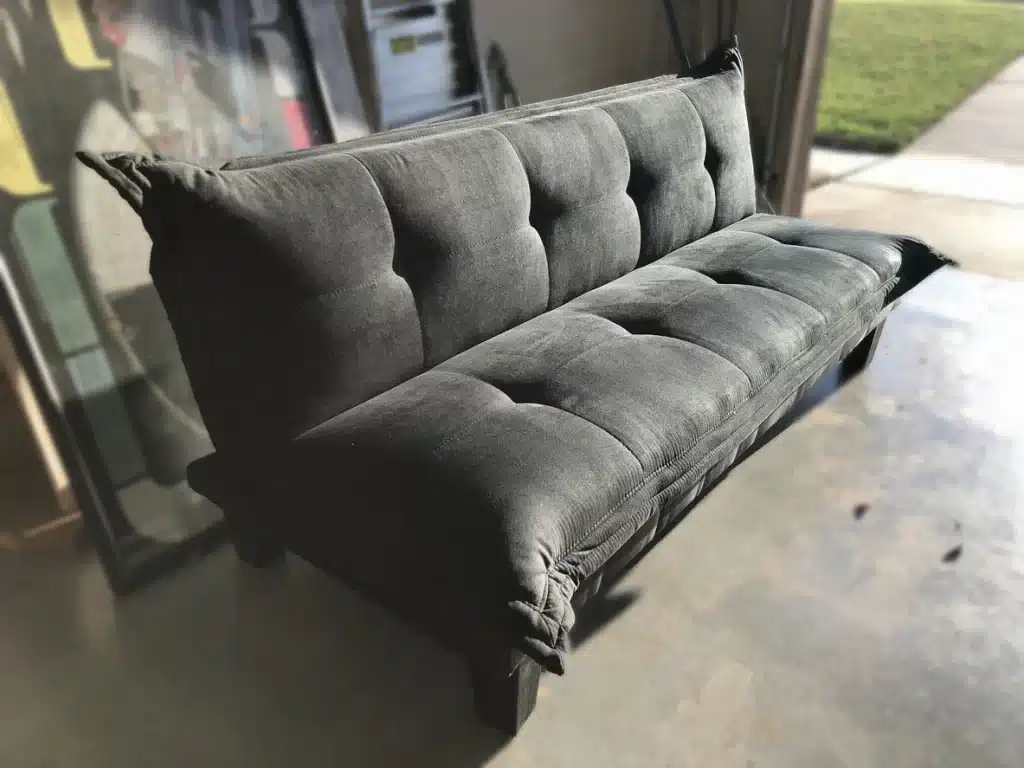Futon mattresses are an increasingly popular choice of furniture due to their versatility, affordability, and minimalist design. However, a common problem with futons is that the mattress can slide, which can be a major annoyance for owners. Fortunately, there are various methods you can use to keep the mattress in place and prevent it from sliding ever again.
1. Troubleshoot the Futon’s Frame
The first step is to troubleshoot the futon’s frame. Wobbly or tilted futon frames can cause the mattress to slide, particularly if you move around a lot while sleeping. Take a look at your frame and look out for loose bolts, uneven feet, or an uneven surface in general. If that’s the case, try tightening the bolts of your frame and checking whether it’s level by placing a spirit level on top of it. You may also want to consider moving your futon to an area where the floor is even and free from obstructions like carpets or rugs.
Read also: Why do we sleep on raised beds?
2. Use Corner Straps
The use of corner straps to keep a futon mattress from slipping and sliding is one of the most popular and effective methods. This is because these straps are designed specifically for futons, ensuring that the mattress is held firmly in place at all times. Despite the fact that futons are traditionally known for their portability, this feature can be quickly negated if the mattress shifts or moves during sleep.
These straps come in a variety of styles, so finding one that fits your particular futon should be relatively straightforward. In general, they are easy to install and adjust to your desired level of tension. To properly attach corner straps to a frame, begin by looping them through each of the four corners closest to where the mattress will lie on top of it; then pull it tight and securely fasten it with either Velcro or clips.
In addition to preventing unwanted shifting during use, corner straps also provide additional stabilization when converting your futon from a couch into a bed. Futons tend to become progressively looser over time due to wear and tear; however, with corner straps in place you can reduce this tendency significantly. Even better yet, since corner straps don’t require any tools or specialized knowledge to install, using them is an inexpensive way to ensure your futon remains stable for years on end.
When selecting corner straps for your futon mattress, make sure you choose ones that are designed for this specific purpose – as some materials simply won’t stand up to frequent use or shifting weights over time. Additionally, ensure that you have chosen a size compatible with your particular frame as too large or small units can easily become ineffective when put into use. With proper care and installation, these simple devices could drastically reduce slippage and minimize potential accidents related to shifting mattresses during sleep or when changing positions throughout the night.

3. Create Your Own Futon Straps
If you have a knack for sewing and enjoy DIY projects, consider making your own futon corner straps. DIY corner straps are easy and quick to make.
Sew hooks to the underside of each futon corner and attach a piece of elastic band to the hooks. Use a heavy-duty thread to sew the hooks onto the underside of each corner. This will give the straps much more strength and durability than regular thread would. Additionally, make sure to use thick elastic bands when attaching them to the hooks. Thicker elastic bands can provide more tension and keep the mattress from slipping around.
Loop the band under a slat and fasten the remaining hook to the second hook on the corner. Repeat this process for all four corners. This customized solution can help keep your futon mattress in place.
4. Use Velcro to Secure Your Futon
Velcro strips are a great and quick solution to keep your futon mattress from sliding. To get the best results, it’s important to make sure that you have the right kind of materials. Use adhesive Velcro designed for fabric as this type is designed to be strong and non-toxic, so it won’t damage your furniture. Begin by identifying the contact points on the underside of the corners of your futon mattress and the corresponding points on the frame’s slats. Cut eight velcro strips for each corner – two pieces for each side – so that one side attaches onto the futon mattress and the other onto the frame’s slats. Make sure to press firmly as you attach them to ensure a secure hold. This will provide extra friction between your futon mattress and frame, helping keep it in place while you sleep or relax. With these steps, you can easily keep your futon mattress from sliding and enjoy a peaceful night’s rest.
5. Rubber Mats
Rubber mats are widely used to prevent slipping in various settings, such as gyms and yoga studios. The same principle applies to futons. Placing a rubber mat between the frame and the futon can significantly reduce movement. Ensure that the mat covers the entire area of the frame where the futon sits. You can use a single large rubber mat or several smaller ones, such as yoga mats. However, a single mat tends to be more effective, as smaller ones may move. Custom-cut rubber mats are also available in many stores.
Rubber mats can also provide additional support and cushioning for your futon mattress. This is especially beneficial if you’re using a thin or lightweight futon mattress, as they tend to be more vulnerable to sliding and shifting. The added layer of cushioning also helps improve the overall comfort of your mattress.
When shopping for rubber mats, look for high-density versions that are specifically made for use on furniture. These thicker, sturdier mats provide better grip and stability than thinner rubber varieties. Additionally, it’s important to measure the area where your futon rests in order to get the right size mat for your frame.
Additionally, you can choose from a variety of different textures when selecting a rubber mat for your futon mattress. Many feature an anti-slip surface that’s designed to reduce slipping even further and promote increased traction between the frame and mattress. Some even have raised dimples or grooves which act like suction cups – creating a stronger bond between the two components.
Read also: Can you sleep on a mattress topper on the floor?
6. Futon Grip Strips
Futon grip strips are an effective way to keep your futon mattress from slipping and sliding. They are pre-manufactured, easy to install, and offer a secure and strong hold for your mattress. These strips have adhesive on them to stick to your mattress without requiring any additional glue.
To ensure the best results, you should make sure that you have enough strips to cover the top and bottom of your futon frame. Additionally, be sure to read customer reviews before purchasing the product to make sure it is the right choice for you. If properly installed and of high quality, futon grip strips can provide a reliable and long-term solution that will keep your futon mattress secure on its frame.
Read also: How to keep bed sheets in place
7. Non-Slip Futon Covers
Most futon mattresses tend to have a slippery fabric outer. Non-slip futon covers are an effective and attractive solution to keep your futon mattress from sliding. The cover is made of materials that have a higher friction coefficient, providing excellent grip on any surface. Not only does this help prevent movement of your mattress but also helps extend its life. This is because the non-slipping material protects the material of your mattress from wear and tear caused by friction.
Additionally, non-slip futon covers come in a wide range of colors, patterns, and materials to choose from so that you can find one to match your home’s decor.
8. Add a Headboard or Footboard
Unlike a traditional bed frame, such as a wooden frame, futon frames do not typically have a headboard or footboard. However, this does not mean that one cannot be added.
Adding a headboard or footboard to your futon frame can provide additional support, reduce motion transfer, and prevent the mattress from sliding across the frame. This is especially useful if your futon is positioned against a wall or if there are multiple people using the futon. Consider attaching the headboard or footboard to the metal or wooden frame using angled brackets or other secure methods available at hardware stores. Ensure that these attachments do not interfere with the futon’s folding mechanism and that all screws, bolts, and fasteners are tight and secure. Additionally, when choosing a headboard or footboard for your futon bed, opt for a design that coordinates with the surrounding decor in your bedroom while also providing the necessary support and stability.
9. Use Furniture Grippers or Pads
Furniture grippers or pads are a great way to keep your futon mattress secure and prevent it from sliding. They come in various designs and sizes, so you can choose the perfect fit for your futon frame. Additionally, they can provide extra padding and protect your floor from scratches. Grippers are usually made from rubber or nylon, so they’re durable and easy to clean. For an extra secure fit, try using furniture pads in the areas of the frame that come into contact with the mattress, such as the corners and sides. This can help to create more friction and keep your futon from slipping around.
10. Use a weighted blanket
A big part of the reason why your futon mattress slides during the night is that you move around a lot – and this causes movement in the futon itself. If you move less, the mattress will move less and will not slide around so much.
To help you stay in place during the night you can try using a weighted blanket. This type of blanket is made with special fabric that is filled with tiny beads and weighs around 10-20 pounds (4.5-9kg). The weight of the blanket not only has a calming effect but also prevents you from moving too much during the night, thus helping to keep your futon mattress in place.
11. Regular Maintenance
Regular maintenance of your futon is essential in order to ensure that it stays secure and stable. Tightening any loose bolts or screws on the frame will help keep the mattress from shifting and sliding. Additionally, make sure that the slats are properly secured and evenly spaced to provide adequate support for the mattress. Regularly flipping and rotating your futon mattress will help maintain its shape, reduce sagging, and prevent sliding. Cleaning the futon regularly with a vacuum can also help keep it looking and performing at its best for years to come.
Read also: How to keep blankets from sliding off the bed
Conclusion: How to keep a futon mattress from sliding
Futon mattresses can be a great choice for those looking to save money, create more space in their home, or just enjoy the minimalist aesthetic. But if your futon mattress is sliding around and you find yourself constantly readjusting it, these 11 easy solutions should help keep it secure and stable. Whether you choose to add non-slip covers, attach headboards or footboards, use furniture grippers or pads, employ weighted blankets or simply perform regular maintenance on your futon frame – there’s sure to be an option that works best for you! With any of these methods implemented correctly -you’ll have no trouble keeping your futon mattress from sliding around so that you can get a good night’s rest without interruption.
